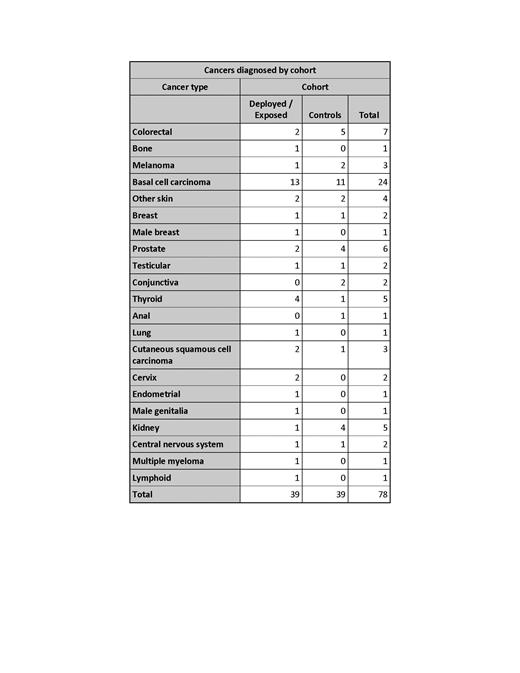Introduction: Burn pits have known individual carcinogenic byproducts, including polyaromatic hydrocarbons and volatile organic compounds, which have a presumptive link between deployment exposure and tumorigenesis. However, there are a dearth of epidemiologic data describing the long-term cancer incidence in U.S. service members who were exposed to burn pits during deployment to Iraq. A retrospective cohort study was carried out with the goal of assessing long-term cancer risk in service members who deployed to Iraq and reported exposure to burn pits.
Methods: Data were collected from the Armed Forces Health Surveillance Division. Inclusion criteria were any service member who deployed to Iraq (Joint Base Balad or Camp Taji) between January 1st, 2005 to June 30th, 2007, whose deployment lasted at least 180 days, who reported burn pit exposure on their post-deployment health assessment form, who were at least 35 years old at the time of their deployment, who remained in the military for at least 10 years post-deployment, and who had post-deployment serum available in the DoD Serum Repository. Controls were individually matched to the research cohort by age (+/- 3 years), sex, branch of service, rank, and occupation category. To minimize confounding from the “healthy deployer effect”, controls were also required to have deployed to Germany for at least 180 days, and to have been at least 35 years old at the time of their deployment. Controls could not have ever deployed to Southwest Asia or reported burn pit exposure. Cancer incidence was captured via ICD-9 and -10 codes of 140-209 and C00-C96, respectively. Primary endpoint was assessment of serum monoclonal gammopathy in deployed, exposed personnel vs. non- deployed controls. The secondary endpoint was assessment of long-term neoplasia development via ICD-code, which is reported here. A Fisher test was used for comparison of post- deployment malignancies between deployed/exposed service members and controls. This study was exempt from full IRB review and funded by Murtha Cancer Center Research Program.
Results: 534 deployed/exposed service members and 534 matched controls met inclusion criteria. Median age at deployment was 37 (range: 35-55). Most service members were white enlisted males in the Army. Mean follow up from the end of deployment was 14 years for deployed/exposed members and 10 years for controls. In each cohort, 39 service members (7%) developed malignancy post-deployment (p=1.0), of which solid tumors were exceedingly more common as shown in Table 1. Only two hematologic malignancies were diagnosed, both in the deployed/exposed cohort, consisting of multiple myeloma and a lymphoid malignancy. There were no differences in the number of service members with multiple primary tumor types between the exposed and unexposed groups. There were also no differences in the number of service members with anemia, hypercalcemia or kidney disease; however, exposed personnel were more likely to develop obesity after their deployment (n=171 vs. 159, p=0.002). Serum monoclonal gammopathy results will be reported separately.
Conclusions: Service members who deployed to Iraq between 2006-2008 for at least 180 days, who reported burn pit exposure, and who were followed for an average of 14 years post deployment did not have higher rates of plasma cell disorders or any other malignancy than matched controls who deployed to Germany. Limitations of epidemiologic studies on service members include response bias on post-deployment health assessment forms, inability to capture service members who leave the military, and lack of details on Veterans seeking healthcare through the VA system or civilian healthcare system. It is possible that with a more expansive patient cohort that includes Veterans and longer follow up, that a difference in cancer incidence could emerge. Further research is needed to better understand cancer risk factors in service members.
Disclaimer: The contents of this publication are the sole responsibility of the author(s) and do not necessarily reflect the views, opinions or policies of Uniformed Services University of the Health Sciences (USUHS), The Henry M. Jackson Foundation for the Advancement of Military Medicine, Inc., the Department of Defense (DoD) or the Departments of the Army, Navy, or Air Force. Mention of trade names, commercial products, or organizations does not imply endorsement by the U.S. Government.
Disclosures
Landgren:Merck: Consultancy, Honoraria, Membership on an entity's Board of Directors or advisory committees, Other: Membership on independent data monitoring committees; Amgen: Consultancy, Honoraria, Membership on an entity's Board of Directors or advisory committees, Other: Membership on independent data monitoring committees; Takeda: Consultancy, Honoraria, Membership on an entity's Board of Directors or advisory committees, Other: Membership on independent data monitoring committees; Janssen: Consultancy, Honoraria, Membership on an entity's Board of Directors or advisory committees, Other: Membership on independent data monitoring committees; Celgene: Consultancy, Honoraria, Membership on an entity's Board of Directors or advisory committees, Other: Membership on independent data monitoring committees; Adaptive: Consultancy, Honoraria, Membership on an entity's Board of Directors or advisory committees, Other: Membership on independent data monitoring committees; Theradex: Consultancy, Honoraria, Membership on an entity's Board of Directors or advisory committees, Other: Membership on independent data monitoring committees. Kazandjian:Aperture Medical Technology, LLC: Consultancy, Honoraria; Bridger Consulting Group: Consultancy, Honoraria; MJH Life Sciences: Current Employment, Honoraria; Aptitude Health: Consultancy, Honoraria; Bristol Myer Squibb: Consultancy, Honoraria; Curio Science: Ended employment in the past 24 months, Honoraria; Karyopharm Therapeutics: Current Employment, Speakers Bureau; Sanofi: Consultancy, Honoraria; Arcellx: Consultancy, Current Employment, Honoraria; MMRF: Ended employment in the past 24 months, Honoraria; Plexus Communications: Ended employment in the past 24 months, Honoraria; Alphasights: Consultancy, Honoraria.


This feature is available to Subscribers Only
Sign In or Create an Account Close Modal